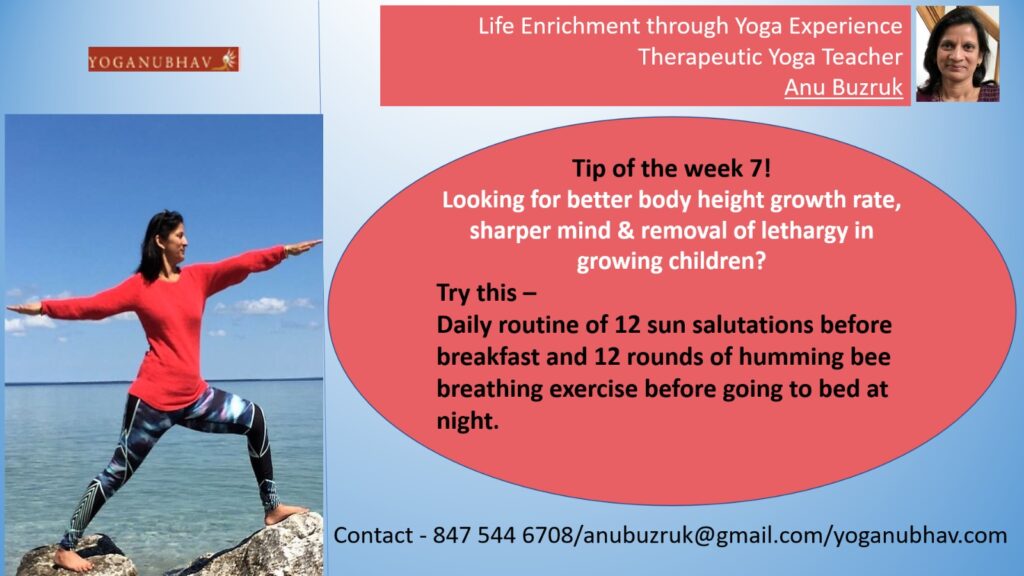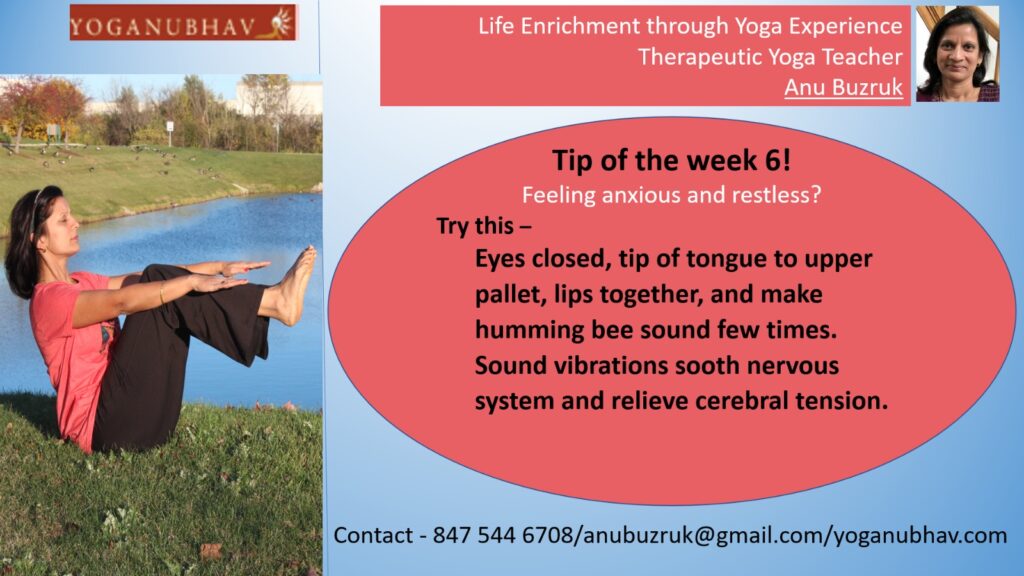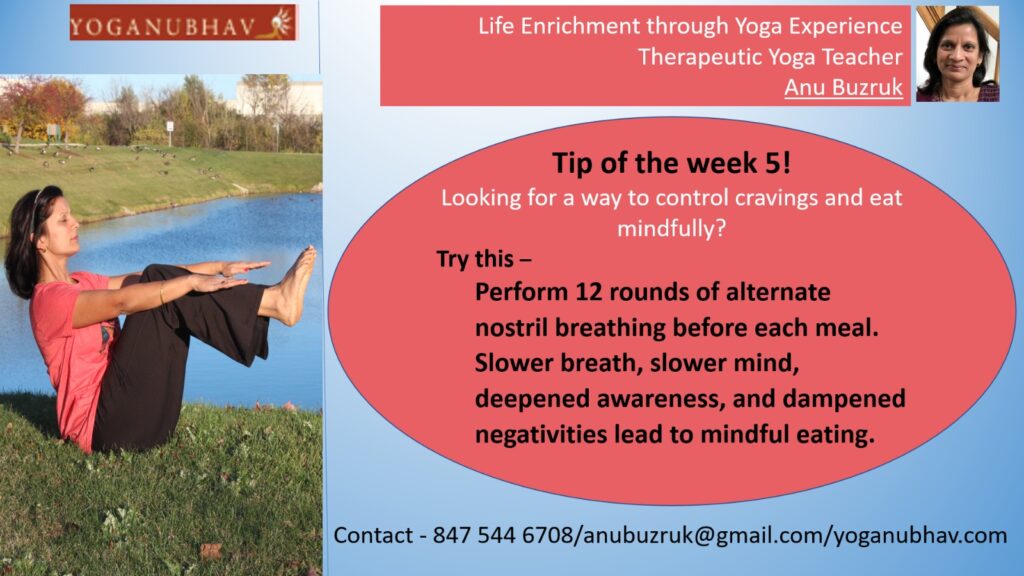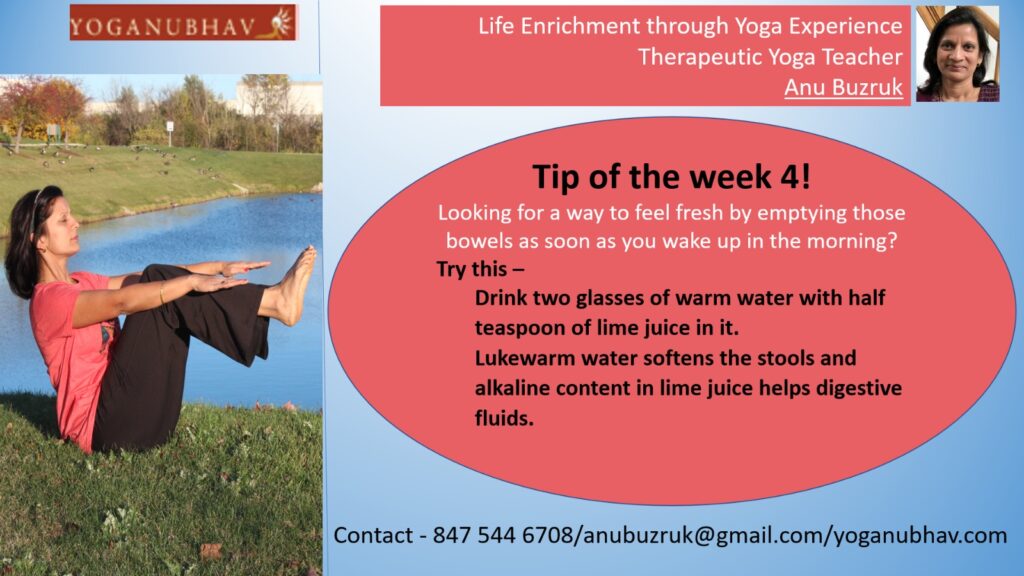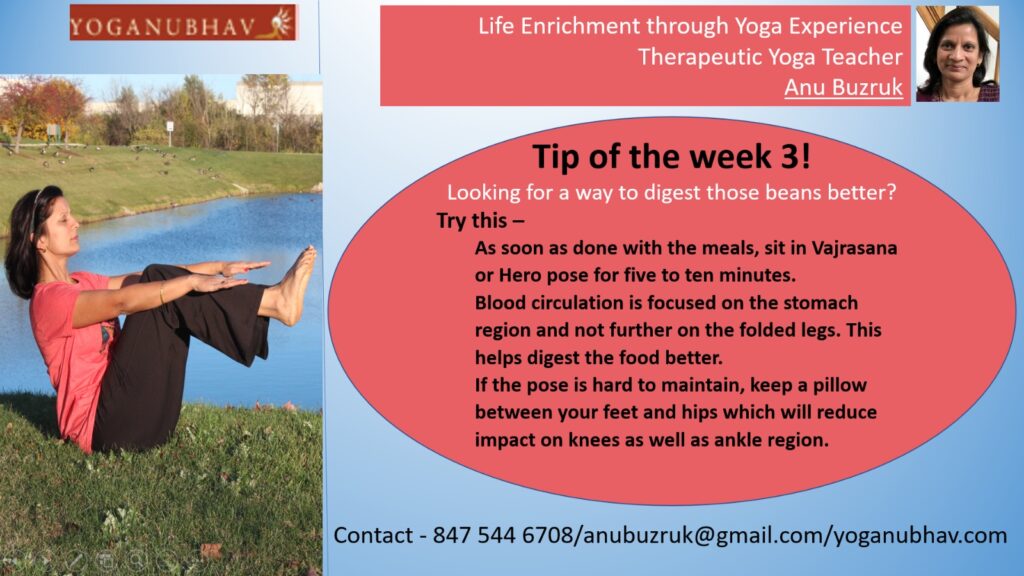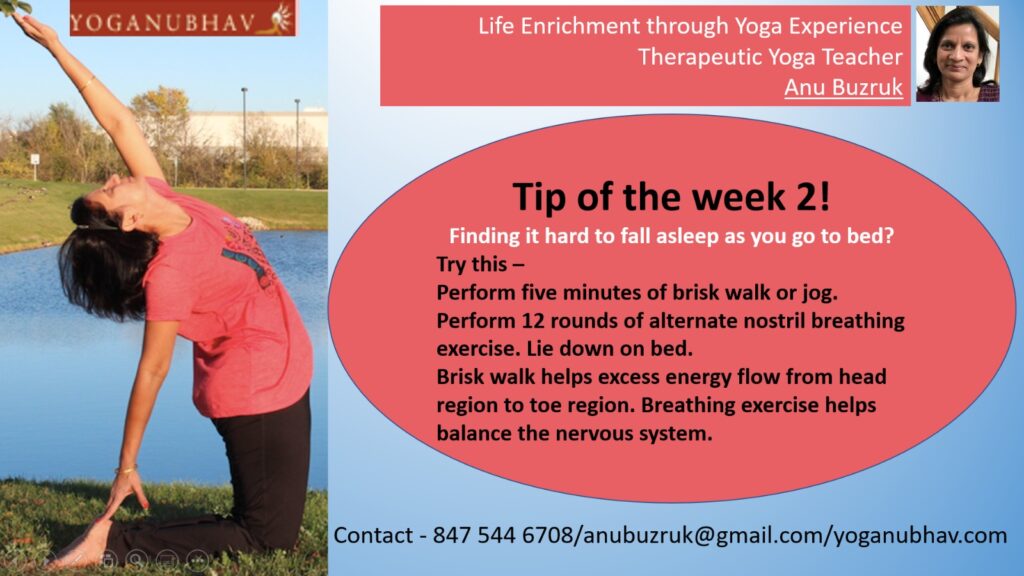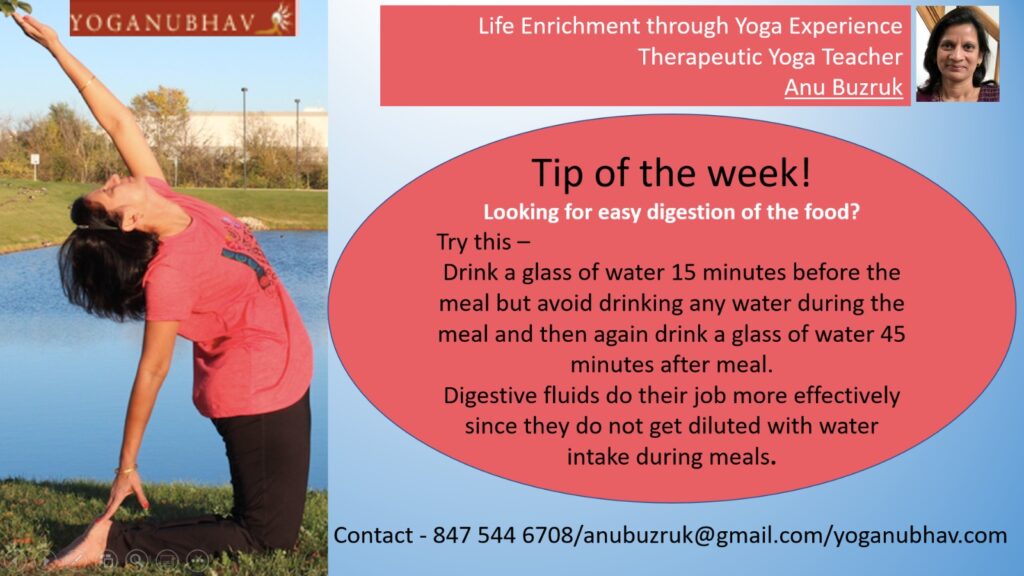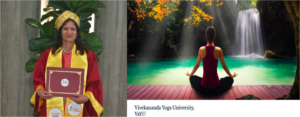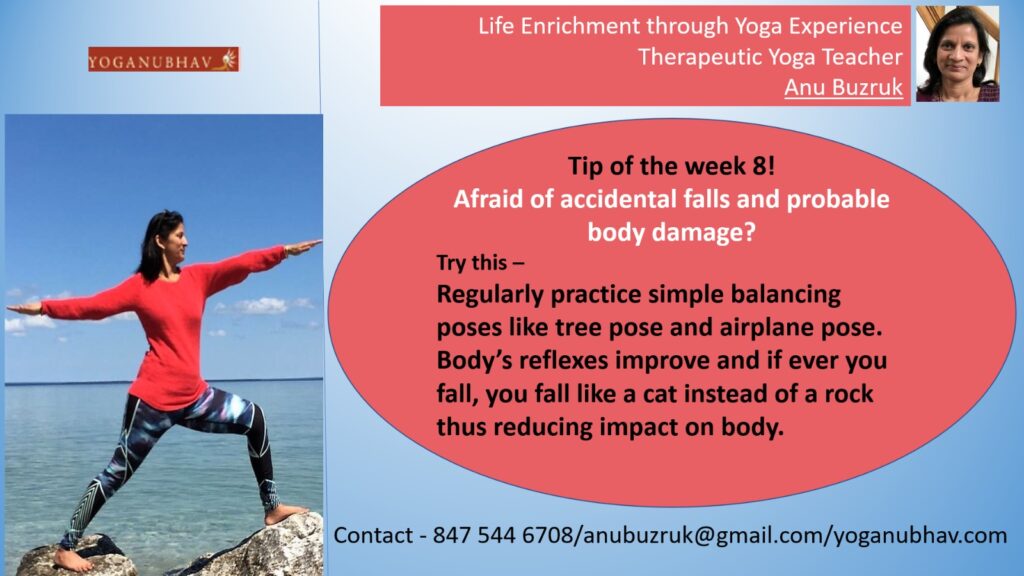
Author Archives: Anu Buzruk
Tip of the week #7
Tip of the week #6
Tip of the week #5
Tip of the week #4
Tip of the week #3
Tip of the week #2
Tip of the week #1
Enrichment Journey
In June 2022, I completed a master’s in the science of Yoga, with a specialization in Yoga Therapy, from Vivekananda Yoga University, VaYU in Los Angeles. Today I would like to share more information about this amazing journey.
This is the first yoga university outside of India focused on “graduate yoga education and research”. It is also the first yoga university in the USA. Mine was the first batch of students graduating with a master’s degree.
I thoroughly enjoyed the four-semester-long enrichment that I received from utterly knowledgeable and experienced faculty. The faculty is recruited from the US as well as from India. The program is centered on an evidence-based yoga routine and a modern scientific approach to the traditional ancient Indian practice of yoga. Thus, the faculty includes experts from different fields like modern medicine, naturopathy, ayurveda, ancient yogic scriptures, yoga philosophy, research methods, research in the field of yoga and Biomedical science, clinical yoga therapy, so on and so forth.
The program focuses on yoga therapists being able to help the clients manage different medical conditions, especially non-communicable diseases which are borne out of stress. (A medical doctor may diagnose, prescribe medications, and may refer the patient to the yoga therapist so the patient can manage the medical condition with lesser stress.)
- The first semester gives a comprehensive knowledge about the therapeutic basis of yoga as mentioned in ancient yogic texts like Bhagavadgita, Patanjali Yoga Sutras, and in other systems of Indian Medicine like Ayurveda and Naturopathy. Thus, the semester introduces us to the concept of a human entity at physical, pranic, mind, emotional and spiritual levels, and one’s ability to recognize and remove stress, maintain a balance of one’s own nature and be able to manage the impact of stress on the physical body.
- The second semester gives comprehensive medical knowledge of different diseases. It introduces respiratory disorders like asthma and respiratory infections, cardiovascular disorders like hypertension and coronary artery disease, endocrine and metabolic disorders like diabetes, hypothyroidism, hyperthyroidism, and obesity, excretory system disorders like irritable bladder and stress incontinence, gynecological disorders like PCOS and PMS, gastrointestinal disorders like peptic ulcers, IBS, and ulcerative colitis, Musculo-skeletal disorders like back pain, neck pain and arthritis, neurological disorders like migraine headaches, epilepsy, psychiatric disorders like anxiety, depression and substance abuse, diseases like cancer and kidney disease.
- The third semester focuses on yoga therapy techniques to manage the above diseases. These techniques include yoga asanas or poses to attain balance at the physical level, pranayama or breathing techniques, and certain energization techniques to attain balance at the pranic level. Then it also focuses on certain advanced meditation techniques that help one with managing chronic stress or tension and take care of destructive emotions which are the root cause of non-communicable diseases.
- The fourth semester includes working on a specialization area which can be yoga therapy or yoga philosophy or yoga research. I have been working as a certified yoga instructor for more than two decades and always had a therapeutic approach toward yoga in my teaching. Hence, I chose the yoga therapy specialization path. Here, I learned the pathophysiology of different disorders from clinicians in the related area of specialization like cancer, heart diseases, etc. I also analyzed evidence-based research studies done to support the use of yoga therapy in the management of these health conditions. I did an 8-week research study on yoga techniques useful in managing hot flashes and sleep disturbance in the menopause phase of women and submitted as well as presented a thesis. This gave me a glimpse of the Ph.D. program of the University. This semester also focused on yogic techniques to make pregnancy and post-pregnancy a healthy and joyful process. Finally, I learned how to recognize the choices of various yoga techniques for the effective management of each health condition. The program also introduces you to certain yoga modules to be used for specific health conditions. For example, for diabetic patients, there is a specific module or routine.
The best part of the program, in my opinion, is the source of these yoga modules. These modules are the creation of SVYASA, Bangalore, India, the very first yoga university in the world https://svyasa.edu.in/. This university has had its own research facility for over 30 years. With the best technology available, evidence-based research is carried out to understand the biology of yoga at multiple levels – physical levels to more subtle levels of the existence of humans. These modules have helped bring yoga into the limelight for its therapeutic values.
If anyone wants to learn authentic, original yogic science and the integrated approach of yoga therapy in conjunction with modern medical science, I will highly recommend Vivekananda Yoga University, VaYU. It is a cohort-based online program but at the end of the first and third semesters, students are expected to attend a weeklong hands-on training program at the University’s Los Angeles campus. This could not happen in my case due to Covid-19 and it was replaced by live video sessions. I am enjoying the process of putting this knowledge and wisdom to practical use while continuing to guide my students on their path of wellness and while working on clients being referred to me by medical doctors.
Anu Buzruk
847 544 6708
Yoga and non-communicable diseases (NCDs) in middle age
Communicable/transmissible diseases (e.g., cholera, chickenpox, measles, and malaria) were major problems in the previous centuries. Now, they are pretty much under control (exception being COVID19) with the help of antibiotics, antiseptics, vaccines, etc.
In the present century, we are facing a large number of non-communicable diseases. These are the diseases that are not governed by outside, they are not contagious, but they are due to internal imbalance and malfunctioning of body organs.
Cardiovascular diseases, cancers, chronic respiratory diseases, back pain, neck pain, diabetes, obesity, and depression are some of the examples of NCDs.
They can be a result of a combination of factors –
- Genetic factor – aging population.
- Environmental factor – ventilation.
- Physiological factors – lack of healthy diet, physical activity, sleep, and exercise.
- Behavioral factors – smoking, drug addiction, and harmful use of alcohol.
Let us focus today on the ‘emotion’ component that may lead to the last two factors – physiological and behavioral factors. Negative emotions may lead to stress, anxiety, and tension. These may contribute towards weight gain, addiction, obesity, high glucose levels, high insulin levels, and so on. Yogic way of life can help one take care of these negative emotions.
Yoga philosophy believes in human being made of five sheaths (कोष) or layers of existence –
- Physical body (अन्नमय कोष)
- Vital body where life energy flows through invisible channels or nadis (प्राणमय कोष)
- Mind body (मनोमय कोष)
- Intellect body (विज्ञानमय कोष)
- Bliss body (आनंदमय कोष)
Harmony in the first three sheaths can be easily disturbed since ego, consciousness predominates in these sheaths. Excessively strong feelings of like or dislike, sorrow or happiness, hatred or love, distort the personality, tense the muscles, deplete energy level, create chronic fatigue, and obstruct the flow of positive energy to the last two sheaths. This disharmony can further block the free movement of bliss, and one may lose inner peace.
To regain inner peace, one may further aggravate the problem by eating the wrong foods, living in unhealthy surroundings, letting negative thoughts enter the mind. The ultimate outcome of this can be physical ailments, diseases, or NCDs.
Following are some of the ways in which one can take care of these negative emotions through daily practice of below yoga poses-
- Ushtrasana – With shoulders pushed back, chest expanded and an upward gaze, poses like this may help with enhancement in self-confidence.
 (picture credits Ronan and Millan)
(picture credits Ronan and Millan) - Pada Hastasana – With blood circulation towards head region, poses like this may help with brain relaxation.
 (picture credit Elina K)
(picture credit Elina K) - Vakrasana – With poses like Vakrasana that involve gazing backward from the top of the shoulder, it may help with enhancing the ability to let go and move on, ability to let go of any past regrets, pains, and sorrows.
 (picture credit Dipti Karmarkar)
(picture credit Dipti Karmarkar) - Mandukasana – With legs folded at knees and forehead resting on the floor, poses like this may help enhance the ability to be humble, thankful, and respectful.
 (picture credit Bindiya Jinadev)
(picture credit Bindiya Jinadev) - Makarasana – As the weight of the head is thrown on crossed arms, with peculiar pressure around pineal and thyroid glands, this pose may help improve their secretion and thus calm down the mind.
 (picture credit Sangeeta Gupte)
(picture credit Sangeeta Gupte) - Supta dandasana – With legs resting on the wall and blood flowing from the toe region to the hip region, there may be an improvement in heart rate variability leading to slowing down of the mind.
 (picture credit Vijay Gupte)
(picture credit Vijay Gupte) - Jalandhar bandh – With chin pressed on the throat and peculiar pressure around pituitary and pineal glands, this bandh may help culture the emotions, heal the spirit, and reduce the tendency to get anxious and angry.
 (picture credit Bindiya Jinadev)
(picture credit Bindiya Jinadev) - Bhramari pranayama – With the resonance of humming sound reaching the nerves and cells, breathing may slow down, the flow of prana in the head region may regulate and it may help with brain relaxation.
 (picture credit Archana Joshi Paranjape)
(picture credit Archana Joshi Paranjape) - Cyclic meditation – Through cycles of stimulation and relaxation, this process may train the mind into relaxing after any needful stimulation in day-to-day life. You can read more about this technique in my blog.
You may perform each pose for 30-60 seconds.
All this is just the tip of the iceberg. The yogic scriptures as well as years of evidence-based research done at Institutions like Svyasa, Bangalore give us a huge resource base to help ourselves with our emotional wellbeing and thus ability to manage non-communicable diseases.
To learn these techniques and take control of your health, contact me at anubuzruk@gmail.com or 847 544 6708 or visit my website www.yoganubhav.com.
I look forward to enriching your life through Yoga practice.
Anupama Buzruk
Certified Yoga Instructor
Currently pursuing
Master of Science – Yoga Therapy

